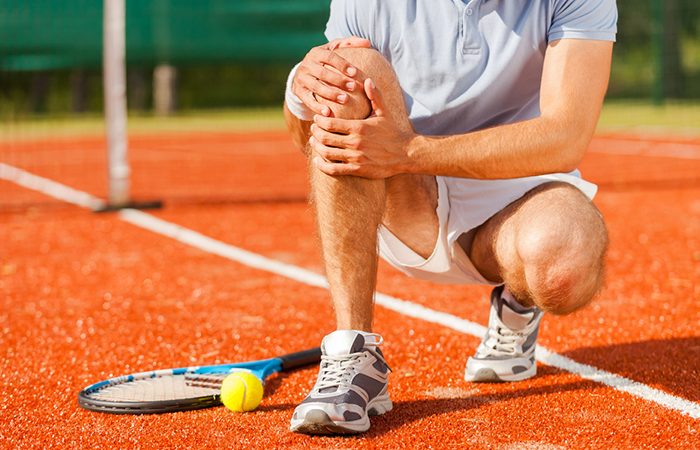
By Ross Smith (Paramedic, Australian First Aid)
I am sure you are all aware that tennis is a complex physical sport requiring hand-eye coordination and full body participation to run, position, swing, and hit. Because of these demands, endurance, flexibility, and muscleconditioning exercises are important to prevent injuries.
Some tennis injuries may be random occurrences (such as those that are the result of a fall etc. this is way all tennis players should have a basic understanding of first aid). However, most injuries can be minimised or prevented entirely by proper conditioning, proper technique, appropriate equipment, and seeking medical attention for persistent, painful conditions in a timely fashion.
Most Common Injuries associated with tennis are:
- Tennis Elbow (see previous news article on tennis elbow)
- Rotating cuff tendinitis (shoulder blade)
- Wrist Strains
- Back pain
- Knee pain
- Calf & Achilles tendon
- Tennis toe
Rotator cuff tendinitis
The rotator cuff consists of muscles and tendons that originate from the scapula (shoulder blade) and attach to the humerus (upper arm bone). These muscles and tendons allow the shoulder to move in many directions. As a result of overuse, you can develop tendinitis, or inflammation of the tendons.
Rotator cuff tendinitis in recreational tennis players usually results from excessive overhead serving. This is more likely to occur if you hold your arm at a 90-degree angle from your side while you are serving. Changing your technique to increase the angle between your arm and side to more than 90° (ideally 135°) will lessen the chance of injury to your rotator cuff.
Treatment for this condition is rest, ice, and non-steroidal anti-inflammatory drugs such as ibuprofen. If symptoms persist after 7 to 10 days of this treatment, see your doctor. If symptoms resolve only to recur when you return to play, it may be worth looking at you playing technique and seek coaching, this may help to prevent recurrence.
Wrist Strains
Wrist strains seem to be related to the “laid-back” grip position: rotating the palm upward and quickly turning your wrist over as you hit the ball in order to achieve topspin. The best grip position for preventing wrist and elbow injuries is the “hand-shake” grip, with the racquet making an “L” position with the forearm.
Once again best treatment is rest, ice and anti-inflammatory medications; get coaching advice may also assist in reducing this injury reoccurring.
Back pain
Back pain seems to be related to an exaggerated arched, or swaybacked, posture used for power production during service strokes. This exaggerated position stresses the small joints and soft tissues of the spine. Older tennis players seem to have the most back pain due to progressive stiffness and degenerative disease, such as arthritis. Ask a sports physiotherapist about a conditioning program designed to strengthen abdominal and back muscles and to increase flexibility can minimise back pain associated with tennis.
Knee pain
The most common knee problem in tennis players is anterior (front) knee pain. This is due to either chondromalacia (softening of the cartilage) of the patella (knee cap) or tendinitis, especially at the patellar tendon. Elite and highly ranked recreational tennis players seem to encounter these injuries more frequently than others. This is thought to be related to the “spring-up” action of the knees on the serve
Treatment of acute anterior knee pain involves the usual RICE, but frequently needs to be complemented with anti-inflammatory medications and a shortarc knee-strengthening program to build up the innermost quadriceps muscle in the thigh.
Calf and Achilles tendon injuries
The common underlying cause in both calf muscle and Achilles tendon injuries is a tight calf muscle-Achilles tendon unit. This muscle-tendon unit crosses both the knee and the ankle. You can tell your calf muscle-tendon complex is tight if you cannot raise the ball of your foot higher than the heel of that foot with the leg extended (straight). A sudden overload from pushing off your foot while your leg is fully extended is the usual cause of injury.
Achilles tendinitis involves inflammation of the Achilles tendon as a result of overuse To treat Achilles tendinitis, decrease playing time, take anti inflammatories, use heel lifts in your regular shoes, and diligently stretch the calf muscles with your leg straight.
A ruptured Achilles tendon is more severe than tendinitis. You may feel a sudden snap in the lower leg, as if someone has kicked you in the back of the foot. This is not a particularly painful injury, and a player may be lulled into thinking that the injury is not as severe as it really is.
After an Achilles tendon rupture, a player will be able to walk flat-footed, but will not be able to stand up on his or her toes on the affected side. Treatment can consist of casting or surgery, but surgery is recommended for most Achilles tendon ruptures, especially for athletes.
With tennis leg (a tear of the calf muscle on the inside of the leg) you may feel as if you have been shot in the upper calf by a pellet gun. This muscle tear can be quite uncomfortable. It is important to stop playing immediately and treat the calf muscle with RICE. This may take several weeks to resolve.
Ankle sprains
Sprains of the outer ligaments of the ankle are common in tennis. You can minimise the risk by selecting shoes that are specifically designed for tennis and that have substantial support built into the outer counter of the shoe.
The most effective treatment for ankle sprains is the usual RICE for 24 to 36 hours, then walking with an appropriate support on the ankle. If the swelling, pain, and bruising are severe, see your doctor.
Even after the most minor sprain, some sort of stabilising ankle support is recommended during play for up to 6 weeks.
Tennis toe
Tennis toe can occur as the toes are jammed against the toe-box (shoe toe housing) of the shoe during tennis’s quick starts and stops.
Tennis toe is a haemorrhage under the toenail that can be quite painful. Your doctor will treat this by drilling a hole in the toenail and relieving the pressure.
Prevent tennis toe by keeping your toenails cut short and wearing shoes that provide adequate toe space.
References:
Dr. Nicholas E. Mihelic
Science & Medicine
Sports Medicine
Physio Works




